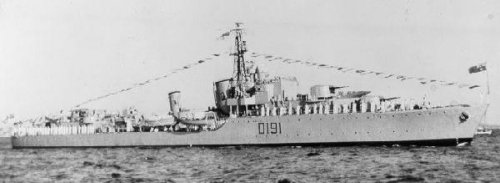
NAVYPEDIA
 Support the project with paypal
Support the project with paypal
Photo

Bataan
Ships
| Name | No | Yard No | Builder | Laid down | Launched | Comp | Fate |
|---|---|---|---|---|---|---|---|
| Arunta | I30, 1950- D130 | Cockatoo DYd | 11.1939 | 30.11.1940 | 3.1942 | sold for BU 11.1968 | |
| Bataan | I91, 1950- D191 | Cockatoo DYd | 2.1942 | 15.1.1944 | 5.1945 | BU 5.1958 | |
| Warramunga | I44, 1950- D123 | Cockatoo DYd | 2.1940 | 6.2.1942 | 11.1942 | BU 2.1963 |
Technical data
| Displacement standard, t | 1959 |
|---|---|
| Displacement full, t | 2519 (later 2710) |
| Length, m | 108.4 pp 114.9 oa |
| Breadth, m | 11.1 |
| Draught, m | 3.96 (later 4.16) |
| No of shafts | 2 |
| Machinery | 2 sets Parsons geared steam turbines, 3 Admiralty 3-drum boilers |
| Power, h. p. | 44000 |
| Max speed, kts | 36.25 - 36.5 |
| Fuel, t | oil 505 - 516 |
| Endurance, nm(kts) | 5700(15) |
| Armament | Arunta, Waramunga: 3 x 2 - 120/45 QF Mk XII, 1 x 2 - 102/45 QF Mk XVI, 1 x 4 - 40/39 2pdr QF Mk VIII, 6 x 1 - 20/70 Oerlikon Mk II/IV, 1 x 4 - 533 TT, 2 DCT, 2 DCR (30 DC) Bataan: 3 x 2 - 120/45 QF Mk XII, 1 x 2 - 102/45 QF Mk XVI, 6 x 1 - 40/56 Bofors Mk III, 1 x 4 - 40/39 2pdr QF Mk VIII, 1 x 4 - 533 TT, 2 DCT, 2 DCR (46 DC) |
| Electronic equipment | type 285, type 286 radars, type 144 sonar Bataan: type 272, type 275, type 291 radars, type 144 sonar |
| Complement | 190 - 250 |
Standard scale images

Arunta 1942

Arunta 1963
Graphics
Project history
"Tribal" class ships became the answer of Britain to occurrence in navies of probable opponents of large destroyers appreciable exceeding on armament standard British destroyers with their four 120mm guns. A starting point in designing of the new ship began requirement of Admiralty to place powerful armament including ten 120mm guns that should ensure the superiority over new foreign destroyers, such as Japanese Fubuki (3x2 127mm guns and 3х3 TT). Besides it, the wish to ensure leaders of "V" class (an initial designation of these ships) the strengthened air defence armament including newest multi-barrelled 40-mm pompoms expressed. Thus especially made a reservation, that the ships should not be so large that require armour protection, but to have the sufficient dimensions for providing of good seaworthiness.
By basic design working out it has appeared what to fulfil all requirements within the limits of the resolved displacement (1850t was an upper limit for leaders according to decisions of the London conference) it is impossible, and after considering of numerous variants were stopped on the design with 8 120mm guns, two quadruple 40mm pompoms (one was excluded from the specification already after the bulding beginning) and 1 quadruple TT (the truth, with a power drive). It was supposed, that the ships of this class will be brought together in a flotilla of seven-shipboard structure, and under the 1935 program building of such flotilla was provided, but this idea have soon refused, having ordered next year not 7, but 9 ships.
Structurally, except transition to heavier twin main gun mounts, application of yacht stem instead of straight one (as planed on sketch design phases on "Tribal") and using on 30 % of more powerful machinery, "Tribal" essentially did not differ from the predecessors: the same internal arrangement and the same cross-section hull framing system. Last also became the main lack of these in remaining very successful ships.
Dominions also have replenished with "Tribal" class ships. Australian have decided to built them by own strength, but with assistance of British specialists, and machinery have been ordered in Britain. Australian "Tribals" originally differed nothing from an English pre-image. First two ships have ordered in the January, 1939, four more in May of the same year. Order for 3 additional units was cancelled before a war. Already during a building structure of armament of the ships have made the changes dictated by experience of the first months of operations in Europe. Basically they repeated works conducted on British "Tribals": in particular, "X" 120mm mount and 12.7mm MGs were replaced by DP 102mm twin and 20mm Oerlikons. Bataan become operational the last and carried 40mm/56 Boforses instead of Oerlikons.
Decision on a building of "Tribals" was accepted also by Canada in 1940, but not at itself, and in British. In 1940 the order on 4 ships has been given out. During an execution of an order in armament was changed in general repeating accepted on the Australian destroyers. More successful arranging of quadruple pompom became unique significant difference. Already after an end of the war 4 more Canadian "Tribal" class destroyers were completed, built in Canada under a little changed design (4x2 102-mm/45 guns and 40mm Boforses).
Modernizations
1944 - 1945, Arunta, Warramunga: - 6 x 1 - 20/70; + 6 x 1 - 40/56 Bofors Mk III
1953, Arunta; 1954, Warramunga: new lattice mast, superstructure was lengthened. - 1 x 2 - 120/45, 4 x 1 - 40/60, 1 x 4 - 40/39; + 1 x 2 - 40/60 Mk 5, 1 x 3 - 305 Squid Mk 3 ASWRL, type 174 sonar
Naval service
No significant events.
 HOME
HOME FIGHTING SHIPS OF THE WORLD
FIGHTING SHIPS OF THE WORLD AUSTRALIA
AUSTRALIA TORPEDO SHIPS
TORPEDO SHIPS ARUNTA destroyers (1942-1945)
ARUNTA destroyers (1942-1945)
